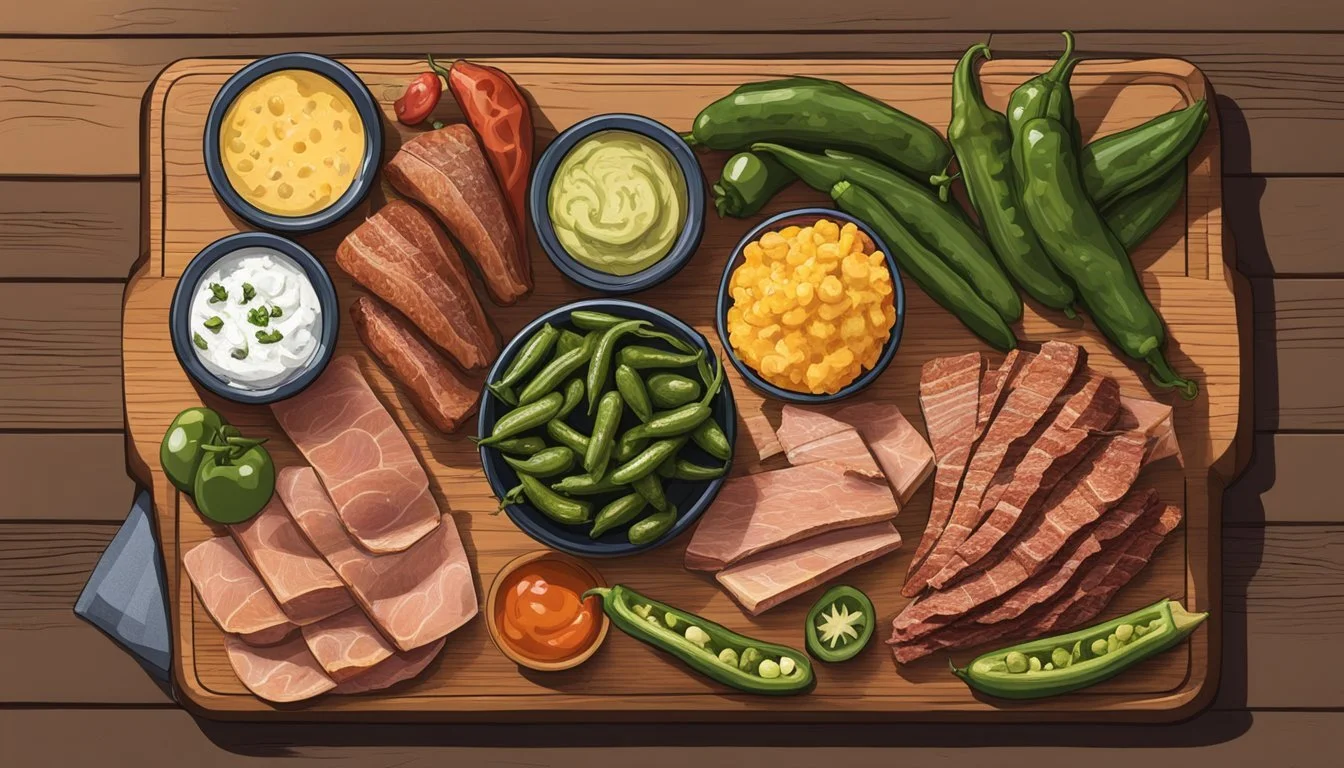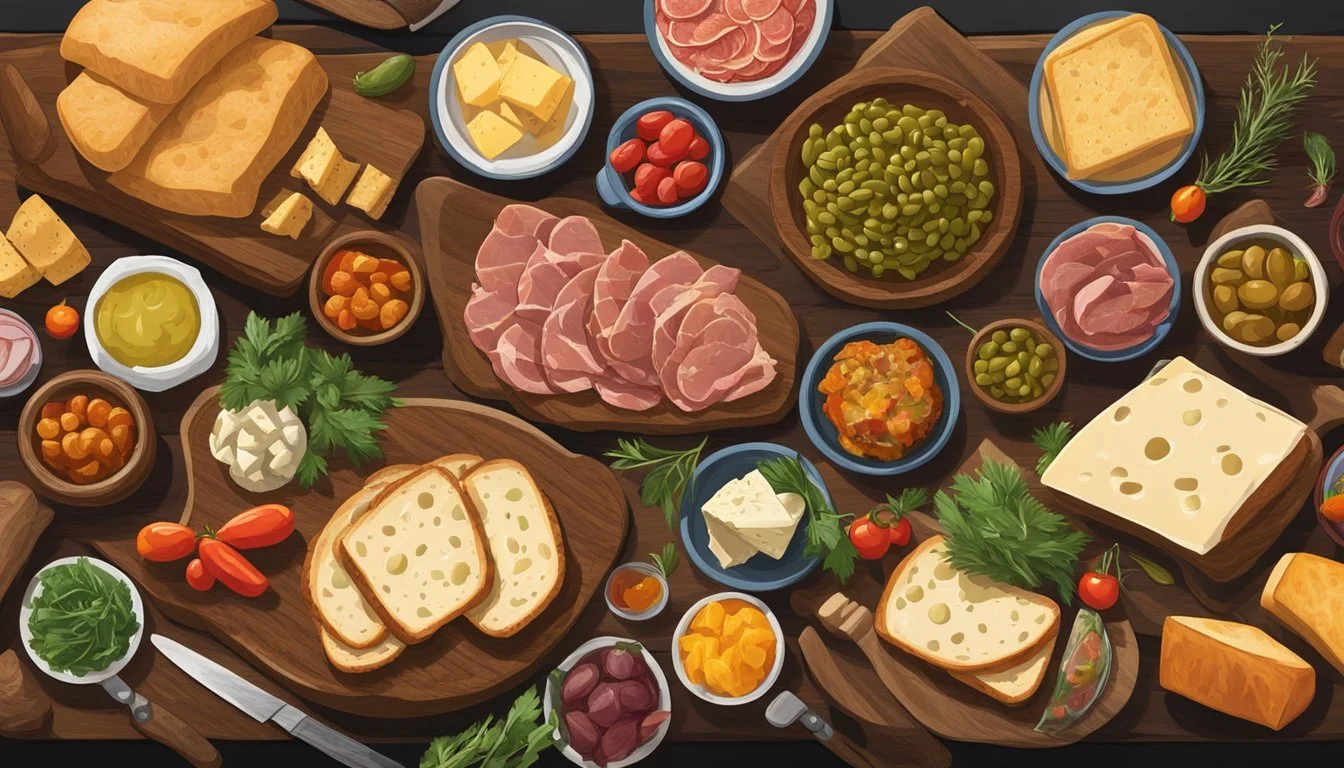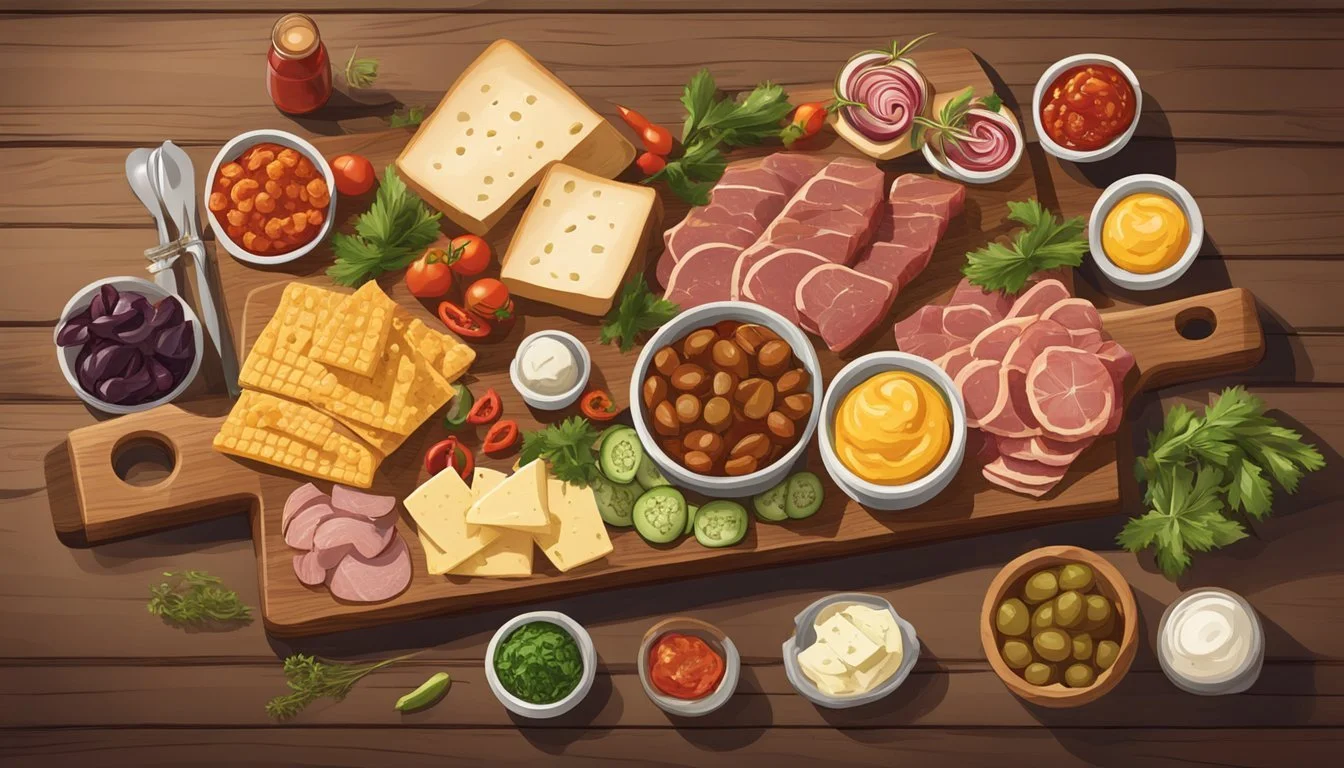How to Prepare a Texas-Style Antipasto Platter
A Guide to Hearty Southern Appetizers
An antipasto platter serves as a delightful appetizer that tantalizes the palate and showcases a variety of flavors and textures. In Texas, where cuisine is a serious affair, the antipasto platter adopts a bold twist, incorporating local ingredients and Southern flair. As foodies gather around the table, a well-assembled Texas-style antipasto platter offers a communal experience, allowing guests to sample an array of bite-sized delicacies before the main meal.
To create a genuine Texas-style antipasto, one incorporates traditional elements such as cured meats and cheeses alongside pickled vegetables (What wine goes well with pickled vegetables?) and spreads that reflect the region's tastes. This could mean using spicy pickled green beans or adding a dash of local barbecue seasoning to a dish. It's not just about selecting high-quality ingredients but also about presenting them in a way that invites diners to explore and enjoy.
Carefully chosen ingredients are arranged on a large platter or wooden board, providing not only a variety of tastes but also an array of colors and textures. Olives, (What wine goes well with olives?) marinated mozzarella, and flavorful dips can be included to complement the selection. The arrangement is key to creating an appetizing display, where each item is easily accessible and the platter as a whole serves as a centerpiece to the social gathering, initiating conversations and enhancing the dining experience.
Selecting Ingredients for Your Platter
An authentic Texas-style antipasto platter draws on the rich tradition of Texan barbecue and Southern hospitality, artfully blending smoked and cured meats with a hearty selection of cheeses and fresh accompaniments. Let’s embark on a flavor-rich journey as we handpick ingredients that promise to create a platter as vast and inviting as the Lone Star State itself.
Choosing Meats
The meats are the centerpiece of any antipasto platter, especially when infusing a touch of Texas. Opt for:
Smoked brisket: Thick slices, full of flavor
Pepperoni: Thinly sliced
Prosciutto: Delicate and cured, draped loosely
Salami: A variety of peppered and spiced cuts
Smoked turkey: Tender slices
Optional: Slow-cooked pork ribs, cut into individual bones
Assorted Cheeses
Choose a range of textures and flavors for the cheese selection:
Sharp cheddar: A Texas favorite, cubed or sliced
Gouda: Smoked or plain, offers a rich creaminess
Provolone: Mild and versatile
Brie: Soft and creamy, can be served as a wedge
Accent With: Grated parmesan over the platter
Pickled and Fresh Vegetables
Freshness and crunch bring balance to the platter:
Pickled vegetables: Include jalapeños, okra, and onions
Zucchini & eggplant: Grilled or marinated
Diversify With: A medley of olives and dill pickles
Breads and Crackers
Hearty breads can stand up to bold Texas flavors:
Baguette: Sliced diagonally
Crostini: For a crisp bite
Pita bread: Soft and perfect for scooping
Vary With: Assorted crackers, offering different textures
Fruits and Nuts
A hint of sweetness complements the savory elements:
Grapes: Sweet and juicy, in clusters
Berries: Strawberries, blueberries, and raspberries offer burst of flavor
Enhance With: A selection of pecans and walnuts
Condiments and Extras
These finishing touches add depth and richness:
Sauces: A spicy barbecue sauce and a smooth Dijon mustard
Oils and Vinegars: Extra virgin olive oil and balsamic glaze for drizzling
Honey: A small bowl of local Texas honey
Expand With: An olive tapenade for a tangy option
Preparing the Texas-Style Elements
Preparing a Texas-Style Antipasto Platter involves smoking meats using traditional Texan methods, whipping up authentic BBQ sauces and relishes, and creating signature condiments that complement the robust flavors.
Smoking Meats the Texas Way
To achieve the authentic smoke flavor of Texas-style meats, one should primarily use woods like oak or cherry in the smoker. For a smoked brisket, it's essential to maintain a consistent smoker temperature between 225-250°F. Meats should be seasoned with kosher salt and coarse ground pepper before being placed in the smoker. Wrapping the brisket in foil after it reaches an internal temperature of 165°F and allowing it to continue cooking until it reaches around 195-200°F will ensure tenderness. After smoking, the meat must rest before slicing to redistribute the juices.
Homemade BBQ Sauces and Relishes
The foundation of a good Texas barbecue sauce starts with a base of vinegar, sugar, and tomato. Adding elements like chili powder can bring a little heat to the sauce. A homemade sauce should simmer on low heat to blend the flavors and thicken to the right consistency. Serving homemade relishes alongside provides a refreshing counterpoint to the rich, smoky meats. A relish might include ingredients such as finely chopped vegetables, vinegar, and a touch of sugar for balance.
Creating Signature Condiments
Signature condiments bring unique and personalized flavors to the platter. A versatile Texas-style barbecue sauce can be mixed using ingredients such as vinegar, honey, Dijon mustard, and a hint of sugar. This sauce should complement the smoked meats (What wine goes well with smoked meats?) without overpowering them. To create an infused olive oil, start with high-quality extra virgin olive oil and add in aromatics like garlic or rosemary; balsamic vinegar can be reduced with a touch of honey to create a syrupy glaze ideal for drizzling over vegetables or cheeses.
Assembling Your Antipasto Platter
Assembling a Texas-Style Antipasto Platter requires attention to the variety of tastes and textures, ensuring that the meats, cheeses, and accompaniments complement each other in flavor and are presented attractively.
Design and Arrangement Principles
When designing a Texas-style antipasto platter, one should strike a balance between variety and harmony. A well-designed antipasto platter draws the eye with color contrasts and varied textures. Using a large serving platter or wooden charcuterie board as the foundation, they can start by placing small bowls filled with vibrant pickled vegetables or dark olives at different points to anchor the design.
Visual Appeal: Brightly-colored food items work well against neutral tones of the cheese and meats.
Balance: There should be a variety of items, including meats, cheeses, fresh and dried fruits, with thoughtful placement to entice all senses.
Portioning and Placement Tips
When placing items on the platter, they should consider the order in which guests will likely try the appetizers (What wine goes well with appetizers?).The following tips can guide them in portioning and placement:
Ease of Access: Arrange the components in groups, making sure each item is easily accessible without disturbing others.
Combination: Pair slices of spicy Texas sausage or brisket next to milder cheeses to balance flavors.
Quantity: For meats and cheeses, allot about 2-3 ounces per person. Ensure that there are ample portions without overcrowding the serving platter.
Using these guidelines, one can assure that their Texas-Style Antipasto Platter will be both inviting and easy to enjoy, with all elements presented thoughtfully and artfully.
Seasoning and Flavor Balance
When preparing a Texas-style antipasto platter, one must pay careful attention to the seasoning and achieving the right flavor balance. The selected herbs, spices, and seasonings should complement the bold tastes characteristic of Texas cuisine, while acids and fats need to be balanced to enhance the overall savoriness of the platter.
Enhancing Flavors with Herbs and Spices
A Texas-style antipasto platter comes to life with the careful incorporation of herbs and spices. Use fresh parsley, thyme, and rosemary to bring refreshing, earthy notes to the assortment. Oregano adds a robust flavor typical in Tex-Mex dishes. Apply these herbs sparingly to avoid overpowering the other ingredients.
Herb/Spice Suggested Pairing Fresh Thyme Cheese and Olive Oil Fresh Parsley Cured Meats and Cheeses Rosemary Roasted Nuts and Marinated Vegetables Oregano Grilled Vegetables and Dips
Using spices thoughtfully is key. Kosher salt and freshly ground black pepper enhance the natural flavors without dominating the palate. A touch of coarse salt on top of sliced tomatoes or a hint of sugar in a balsamic reduction provides a sublime taste experience. Hearty sprinklings of garlic powder can elevate the robustness of the meats.
Balancing Acids and Fats
Balancing acids and fats is crucial for a well-rounded antipasto. Extra virgin olive oil and various vinegars are the cornerstones of balancing flavors. Drizzle olive oil over cheeses for richness and on vegetables to highlight their freshness. Consider these pairings for optimal flavor:
Balsamic Vinegar: Brings a tangy yet slightly sweet contrast to fatty cheeses and cured meats.
Vinegar: Spiked with fresh herbs (how long do fresh herbs last?), it acts as a counterpoint to oily items, cutting through the richness.
Fat/Acid Ideal Use Extra Virgin Olive Oil As a dip, or drizzled over items Balsamic Vinegar On greens or to accent cheeses/meats Vinegar In marinades or as a dressing component
Remember to balance each bite with a suitable acid to cleanse the palate, this can be achieved through pickled offerings or a light squeeze of lemon over avocado slices. The goal is to craft a platter where each savory element is met with a component that offers a refreshing zing, making the entire eating experience harmonious and memorable.
Serving and Presentation Tips
When preparing a Texas-style antipasto platter, the details in serving and presentation can elevate the appetizer to a showcase of culinary craftsmanship. Choosing appropriate serving ware, mastering cutting techniques, and applying garnishing methods are crucial steps.
Choosing the Right Serving Ware
For a Texas-style antipasto platter, one should opt for a rustic yet elegant serving platter, such as a large wooden board or a slab of polished stone. It should be spacious enough to allow for an ample assortment of items while offering a sturdy platform that complements the bold flavors of the Texas-inspired appetizer.
Instruction for Proper Cutting
Meats should be sliced against the grain to ensure tenderness. Cheeses vary; for hard cheeses, uniform slices are best, whereas softer varieties can be presented in chunks for easy selection. When assembling, one should maintain space between items to showcase individual flavors and ensure ease of access for guests.
Garnishing Techniques
Garnishing the antipasto platter with fresh herbs such as parsley, thyme, and rosemary not only adds aromatic appeal but also infuses a hint of Texas flair. Additionally, sprigs of oregano can be placed amongst the items for an herbal touch. Fresh herbs should be used sparingly to avoid overpowering the primary flavors.
Pairing Suggestions
When assembling a Texas-style antipasto platter, the right pairings can elevate the overall experience. Careful selection of beverages and side dishes are essential to complement the hearty flavors of the platter.
Beverage Pairings
In Texas, beverages often play a critical role in balancing the bold flavors of appetizers. For a Texas-style antipasto, bold red wines such as Tempranillo or Zinfandel work well with the rich tastes of smoked meats. For those preferring a lighter touch, chilled rosé offers a refreshing contrast.
Craft beers, particularly pale ales or lagers, also pair nicely, cutting through the richness while complementing the smoked and cured elements of the antipasto. For non-alcoholic options, iced tea—both sweetened and unsweetened—remains a staple in Texas and offers a classic, palate-cleansing option.
Side Dishes
Side dishes should complement, not compete with, the main appetizer. In Texas, simple is often best. Potato salad emerges as a favorite, its creamy texture and savory flavor profiles working well alongside the antipasto components. Here are some specific side ideas:
Potato Salad: A traditional Texas potato salad, sometimes spiked with mustard and pickled elements, provides a tangy contrast to the meats and cheeses.
Coleslaw: A slaw dressed in a light, tangy vinaigrette adds a crisp and refreshing touch, balancing out the heavier items.
Salads: Greens should be dressed lightly to maintain their crispness, offering a fresh counterpoint to the antipasto. A simple vinaigrette with a hint of Texas heat, using local peppers, works well.
Customizing the Platter
When preparing a Texas-style antipasto platter, it's essential to consider the varied dietary needs and preferences of your guests. By incorporating options for dietary restrictions and kid-friendly ingredients, everyone can enjoy a personalized taste of Texas.
Options for Dietary Restrictions
For those with dietary restrictions, it’s thoughtful to include a variety of vegan and dairy-free options. Here are some specific ideas to consider:
Vegan Options:
Vegan cheeses: Use a selection of nut-based or soy-based cheeses.
Veggie skewers: Include grilled vegetables such as bell peppers, onions, and zucchini.
Dairy-Free Options:
Deli meats: Offer a variety of dairy-free smoked meats such as Texas-style brisket or turkey.
Dairy-free dips: Create dips like guacamole or salsa that complement the smoky flavors.
By clearly labeling these items, guests can easily navigate the platter and select what suits their needs.
Kid-Friendly Variations
Creating a section on the platter that caters to younger guests ensures they're not left out from the antipasto experience:
Easy-to-Handle Foods:
Cheese sticks or cubes: These are easy for little hands to grab and often a favorite among kids.
Sliced fruits: Apples and grapes add a sweet element that most kids love.
Milder Flavors:
Mild deli meats: Opt for less spicy options like simple roasted turkey or ham.
Simple crackers: Include plain or lightly salted crackers which are less likely to overpower young palates.
Dedicating part of your platter to these alternatives can help make the experience enjoyable for everyone.
Conclusion: Taking It to the Next Level
An expertly assembled Texas-style antipasto platter serves as a statement piece for social gatherings — a testament to the host's attention to detail and understanding of flavors. For the foodie seeking to elevate this culinary experience during the summer season, the incorporation of Texan elements provides a unique spin on traditional antipasto.
To enhance your platter, consider adding smoked brisket or peppered turkey to the selection of meats, offering a nod to the rich barbecue culture of Texas. Complement these with spicy pickled okra and jalapeño-stuffed olives, introducing a pleasant kick that challenges the palate.
Amp up the platter by integrating mini Texas-style burgers—bite-sized yet packed with flavor, they can easily become the showstopper of your spread. Cornbread cut into small squares can also replace traditional bread options, adding a southern twist.
For dessert, small portions of pecan pie or peach cobbler tantalize the taste buds with a sweet and savory finish. Alternatively, bold bites like chili chocolate squares reflect Texas’s diverse culinary heritage.
Ensure a balanced arrangement by grouping items, encouraging guests to explore flavors:
Meats: Arrange in fanned-out slices or rolls.
Cheeses: Offer a variety, from creamy to sharp









